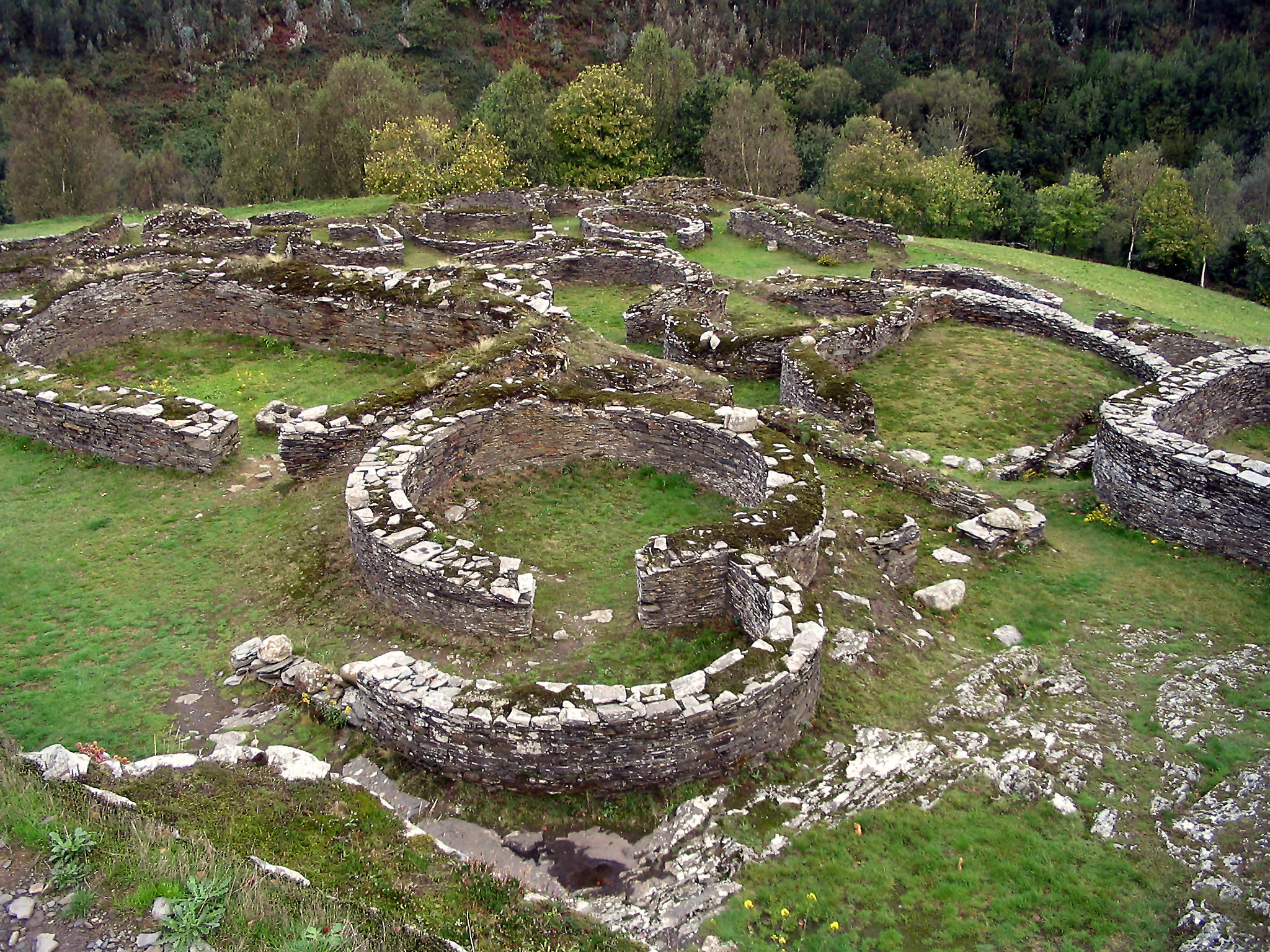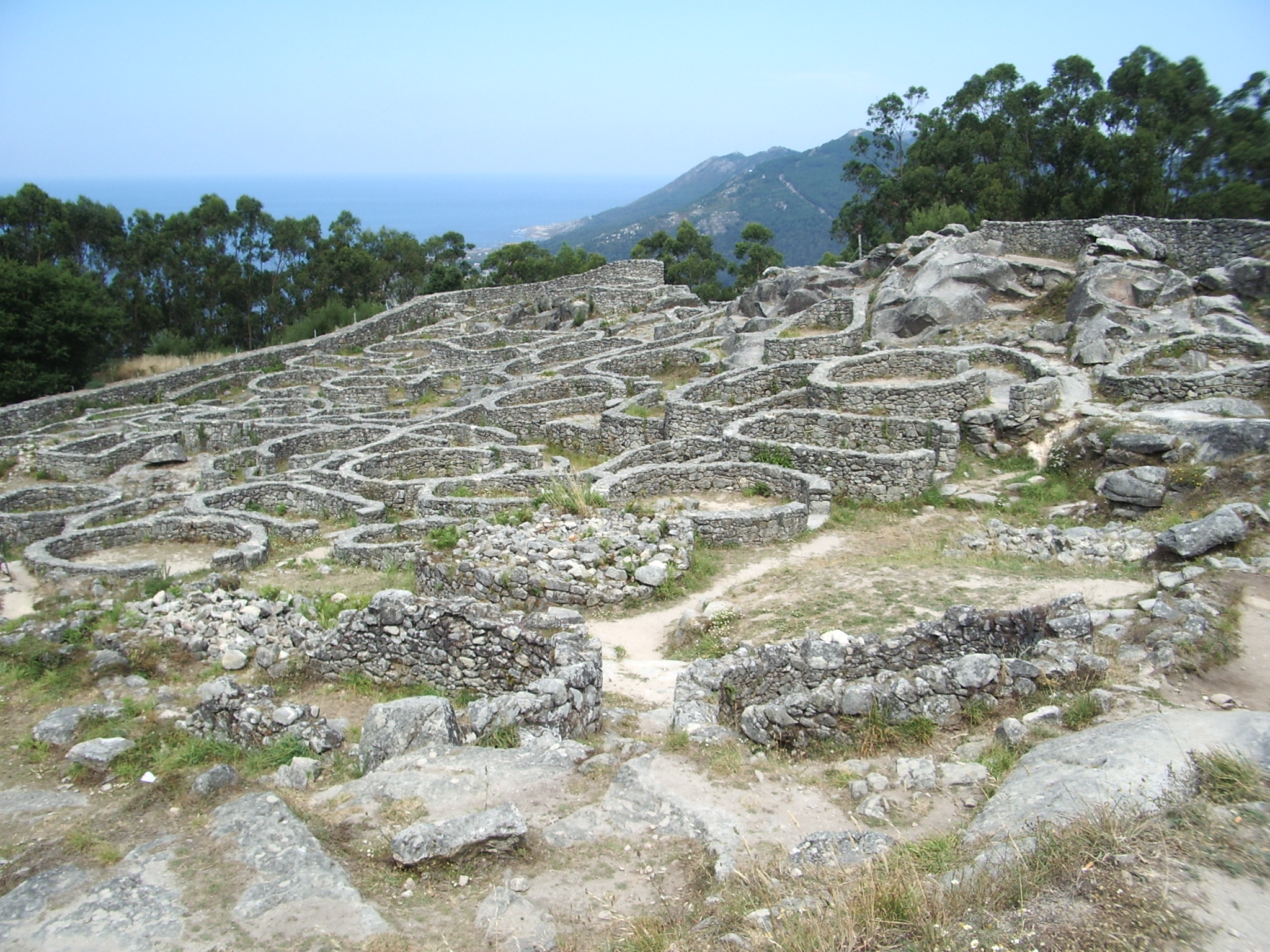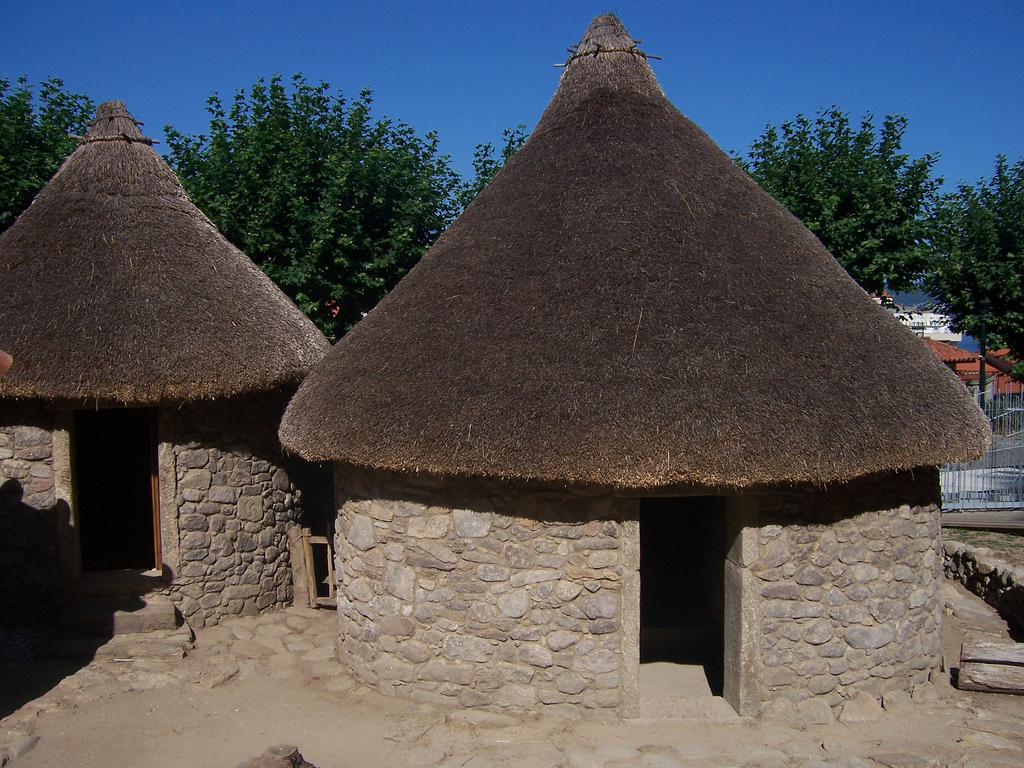Castros (Spain) on:
[Wikipedia]
[Google]
[Amazon]


 A castro is a fortified settlement, usually pre-Roman, some from late
A castro is a fortified settlement, usually pre-Roman, some from late
 The floor of the houses was of mud trod. Prior to the 2nd-3rd century BC, the walls were usually built of adobe, with a central pole. Subsequently, it used masonry more or less in horizontal rows (or polygonal, in some cases). The covers were made of branches covered with mud and reinforced by weights or subsequent of tiles. From the 1st century and due to Roman influence, become more usually square or rectangular. The essential element of a house is the home, that in the change of era was located at the center and was made of slate or clay and by the end of the 1st century it shifted to one side and was, in some cases, with shingles.
It is suspected that some large buildings, where a stone bench runs along the wall and in which are not remains of room, could have been room enclosures. It has also ceramic and pottery kilns, usually next to the exits or outside.
The floor of the houses was of mud trod. Prior to the 2nd-3rd century BC, the walls were usually built of adobe, with a central pole. Subsequently, it used masonry more or less in horizontal rows (or polygonal, in some cases). The covers were made of branches covered with mud and reinforced by weights or subsequent of tiles. From the 1st century and due to Roman influence, become more usually square or rectangular. The essential element of a house is the home, that in the change of era was located at the center and was made of slate or clay and by the end of the 1st century it shifted to one side and was, in some cases, with shingles.
It is suspected that some large buildings, where a stone bench runs along the wall and in which are not remains of room, could have been room enclosures. It has also ceramic and pottery kilns, usually next to the exits or outside.
Official website of the Castro of Chao Samartín and its Museum. A look at the Castro culture in western Asturias and archaeological research in motion
Castros catalog of Ferrol, Narón and Valdoviño.
* ttp://dialnet.unirioja.es/servlet/libro?codigo=234917 The Recent prehistory in Asturias
Castros and castra in Cantabria. Fortifications from the beginning of the Iron Age to the wars with Rome. Catalog, review and update
{{Fortifications Archaeology of Spain Castro culture Types of monuments and memorials Hill forts in Spain Fortifications in Spain Stone Age Europe Bronze Age Spain Iron Age Spain

 A castro is a fortified settlement, usually pre-Roman, some from late
A castro is a fortified settlement, usually pre-Roman, some from late Bronze Age
The Bronze Age is a historic period, lasting approximately from 3300 BC to 1200 BC, characterized by the use of bronze, the presence of writing in some areas, and other early features of urban civilization. The Bronze Age is the second prin ...
and Iron Age
The Iron Age is the final epoch of the three-age division of the prehistory and protohistory of humanity. It was preceded by the Stone Age ( Paleolithic, Mesolithic, Neolithic) and the Bronze Age ( Chalcolithic). The concept has been mostl ...
, the oldest research associated with the Celtic culture. These are frequently found in the Northern Spain
, image_flag = Bandera de España.svg
, image_coat = Escudo de España (mazonado).svg
, national_motto = ''Plus ultra'' (Latin)(English: "Further Beyond")
, national_anthem = (English: "Royal March")
, i ...
, particularly in Asturias, Galicia, Cantabria, Basque Country and the province of Ávila, with the Castro culture
Castro culture ( gl, cultura castrexa, pt, cultura castreja, ast, cultura castriega, es, cultura castreña, meaning "culture of the hillforts") is the archaeological term for the material culture of the northwestern regions of the Iberian Pe ...
and on the plateau with Las Cogotas
Las Cogotas ( es, Las Cogotas) is an archaeological site in Spain in Cardenosa municipality, province of Avila. The site was researched by the Galician archaeologist Juan Cabré in 1920s. It is namesake for two different archaeological culture ...
culture.
The word ''castro'' comes from the Latin
Latin (, or , ) is a classical language belonging to the Italic branch of the Indo-European languages. Latin was originally a dialect spoken in the lower Tiber area (then known as Latium) around present-day Rome, but through the power of the ...
''castrum
In the Roman Republic and the Roman Empire
The Roman Empire ( la, Imperium Romanum ; grc-gre, Βασιλεία τῶν Ῥωμαίων, Basileía tôn Rhōmaíōn) was the post-Roman Republic, Republican period of ancient Rome. As a po ...
'', which means "hill fort
A hillfort is a type of earthwork used as a fortified refuge or defended settlement, located to exploit a rise in elevation for defensive advantage. They are typically European and of the Bronze Age or Iron Age. Some were used in the post-Roma ...
".
Castros of the Castro culture
The castro is a fortifiedvillage
A village is a clustered human settlement or community, larger than a hamlet but smaller than a town (although the word is often used to describe both hamlets and smaller towns), with a population typically ranging from a few hundred ...
that began to be inhabited from the 6th century BC, lacking streets of right angles and full of construction almost always circular. The oldest houses were mostly of straw- mud and the latest masonry. The roof
A roof ( : roofs or rooves) is the top covering of a building, including all materials and constructions necessary to support it on the walls of the building or on uprights, providing protection against rain, snow, sunlight, extremes of te ...
was made of branches and mud and after long poles. Basically, they were unique rooms. These are located in naturally protected areas (heights, riots river
A river is a natural flowing watercourse, usually freshwater, flowing towards an ocean, sea, lake or another river. In some cases, a river flows into the ground and becomes dry at the end of its course without reaching another body of w ...
s, small peninsulas), close to water sources and arable land and on the border between these and higher areas of grazing.
The castros were protected by one or more pits, parapets and walls
Walls may refer to:
*The plural of wall, a structure
*Walls (surname), a list of notable people with the surname
Places
* Walls, Louisiana, United States
* Walls, Mississippi, United States
* Walls, Ontario, neighborhood in Perry, Ontario, C ...
that bordered the inhabited precinct, which may have in its accesses a torreón
Torreón () is a city and seat of Torreón Municipality in the Mexican state of Coahuila. As of 2021, the city's population was 735,340. The metropolitan population as of 2015 was 1,497,734, making it the ninth-biggest metropolitan area in ...
, which controlled the entryways to itself or another strategic location.
In times of conflict, the people who lived in open field moved to these strategically located buildings to ensure their safety. The buildings could also have other purposes such as control of territory, vigilance of crops, etc.
Its situation on the territory compared to other castros suggests that there was a definite strategy when choosing its location, allowing the communication by signals between them as a defensive network.
The maximum flowering time was between the 4th and 2nd centuries BC and show greater business contact with the outside of the south than the north, and the coastal than the inland. Some historians argue that in the first mid-1st century BC there was a multiplication of castros (either for population growth or for other reasons). At the end of the century, coinciding with the final phase of the Roman conquest, some with signs of destruction of the walls and in some cases immediate reoccupation.
Types of castros
Inland castros
These are the most common and characteristic. These are located on hills or prominent elevations, but rarely in high summits. They are circular or oval and have one or more walls. An example is the castro ofCoaña
Coaña (Galician-Asturian: ''Cuaña'') is a municipality in the Autonomous Community of the Principality of Asturias, Spain. It lies along the Cantabrian Sea to the north, and is bordered on the south by Boal, on the east by Navia and Villayó ...
(Asturias
Asturias (, ; ast, Asturies ), officially the Principality of Asturias ( es, Principado de Asturias; ast, Principáu d'Asturies; Galician-Asturian: ''Principao d'Asturias''), is an autonomous community in northwest Spain.
It is coextensiv ...
).
Mountain castros
Located in high mountainous areas, are located on the slopes and are oval, with artificial pits on the upper side and walls or embankments into the valley. Dating back to Roman times and are linked to mining. Two examples include Vilar in theSierra de Caurel
Sierra (Spanish for "mountain range" and " saw", from Latin '' serra'') may refer to the following:
Places Mountains and mountain ranges
* Sierra de Juárez, a mountain range in Baja California, Mexico
* Sierra de las Nieves, a mountain range ...
and Xegunde in Fonsagrada
A Fonsagrada is a town and municipality in the province of Lugo in the autonomous community of Galicia in northwest Spain which is 25 miles east-north-east of Lugo by road. Its population in 2004 was 5,007. A Fonsagrada is situated above sea-l ...
( Lugo).
Coastal castros
Are of varied plant, but usually round or oval, adapting to the terrain. The natural defenses of the sea are complemented by walls and moats into the inland. These are very abundant and an example are the Baroña in the Sierra of Barbanza.Urbanism of the castros
The Castro villages tend to be constructed in cleared hills, rocky headlands or peninsulas that stretch into the sea, which provides visibility, defense and the contour domain. The place of settlement is given also in terms of natural resources exploited by the residents. The castros have an upper enclosure, the "croa" and a series of terraces laid down where are the buildings. Each of these sections may be limited by walls, parapets or pits. Sometimes there is a kind of additions, the antecastros, which is also surrounded by walls but do not harbor houses, so it is assumed that these were intended for animals or orchards. The castros tend to have a single entrance, which also serves to prevent passage. In some cases is a simple thickening of the tops of the walls, in others, a panel of the wall surpasses the other, forming a narrow corridor. It is assumed that they closed with wooden doors. The defenses of the castros do not seem to meet war needs, but of prestige and symbolic boundaries of the inhabited space. In fact, few weapons were found. In addition to natural defenses, there are structures of three types: * Ramparts. Terrain variations formed by earth and stone, which can be natural. These are the basis of the defenses and usually comes from the rubble of the foundational works in the interior. * Parapets. Artificial elevation of the terrain in the most vulnerable points (entrances and flat areas). * Trenches. Gabias long and deep, usually associated with the parapets, which can be dug into soil or rock. * Walls.Masonry
Masonry is the building of structures from individual units, which are often laid in and bound together by mortar; the term ''masonry'' can also refer to the units themselves. The common materials of masonry construction are bricks, building ...
defenses of varied types, such as two parallel walls of stone with stone fill. From the inside up to them by wooden stairs, recessed slabs, ramps or rocks. There may be defensive towers at the accesses to the doors. These are later elements.
The most common is the absence of urban organization. In the 1st century appear clusters of buildings ("neighborhoods"), consisting of several buildings surrounded by a wall with one opening facing the street. This arrangement is common in large towns, and in more modest towns like Castro do Vieito. These may be households in which a building would be housing and the other, silos and warehouses. The houses do not share dividing walls, but are separated from the others. It is not known whether this is a reflection of the idiosyncrasies of this culture or because of the difficulty to do in a circular building. The houses also do not have windows.
 The floor of the houses was of mud trod. Prior to the 2nd-3rd century BC, the walls were usually built of adobe, with a central pole. Subsequently, it used masonry more or less in horizontal rows (or polygonal, in some cases). The covers were made of branches covered with mud and reinforced by weights or subsequent of tiles. From the 1st century and due to Roman influence, become more usually square or rectangular. The essential element of a house is the home, that in the change of era was located at the center and was made of slate or clay and by the end of the 1st century it shifted to one side and was, in some cases, with shingles.
It is suspected that some large buildings, where a stone bench runs along the wall and in which are not remains of room, could have been room enclosures. It has also ceramic and pottery kilns, usually next to the exits or outside.
The floor of the houses was of mud trod. Prior to the 2nd-3rd century BC, the walls were usually built of adobe, with a central pole. Subsequently, it used masonry more or less in horizontal rows (or polygonal, in some cases). The covers were made of branches covered with mud and reinforced by weights or subsequent of tiles. From the 1st century and due to Roman influence, become more usually square or rectangular. The essential element of a house is the home, that in the change of era was located at the center and was made of slate or clay and by the end of the 1st century it shifted to one side and was, in some cases, with shingles.
It is suspected that some large buildings, where a stone bench runs along the wall and in which are not remains of room, could have been room enclosures. It has also ceramic and pottery kilns, usually next to the exits or outside.
See also
* List of castros in Asturias * List of castros in Galicia * List of castros in Cantabria * List of castros in Basque Country * List of castros in the Province of Ávila *Hill fort
A hillfort is a type of earthwork used as a fortified refuge or defended settlement, located to exploit a rise in elevation for defensive advantage. They are typically European and of the Bronze Age or Iron Age. Some were used in the post-Roma ...
*Castro culture
Castro culture ( gl, cultura castrexa, pt, cultura castreja, ast, cultura castriega, es, cultura castreña, meaning "culture of the hillforts") is the archaeological term for the material culture of the northwestern regions of the Iberian Pe ...
*Oppidum
An ''oppidum'' (plural ''oppida'') is a large fortified Iron Age settlement or town. ''Oppida'' are primarily associated with the Celtic late La Tène culture, emerging during the 2nd and 1st centuries BC, spread across Europe, stretchi ...
* Gaztelu zahar
External links
Official website of the Castro of Chao Samartín and its Museum. A look at the Castro culture in western Asturias and archaeological research in motion
Castros catalog of Ferrol, Narón and Valdoviño.
* ttp://dialnet.unirioja.es/servlet/libro?codigo=234917 The Recent prehistory in Asturias
Castros and castra in Cantabria. Fortifications from the beginning of the Iron Age to the wars with Rome. Catalog, review and update
{{Fortifications Archaeology of Spain Castro culture Types of monuments and memorials Hill forts in Spain Fortifications in Spain Stone Age Europe Bronze Age Spain Iron Age Spain